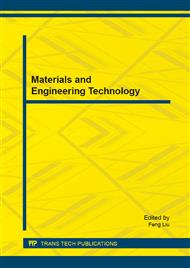[1]
Chen Ching-Wen, Hwang Weng-Sing, A three-dimensional fluid flow model for puddle formation in the single-roll rapid solidification process, Appl. Math. Modelling, vol. 19, 1995, pp.704-712.
DOI: 10.1016/0307-904x(95)00089-3
Google Scholar
[2]
Jun Sunakawa, Yoshio Bizen, Shunsuke Arakawa, Methods for producing iron-based amorphous alloy ribbon and nanocrystalline material,. United States patent US 6678997 B2.
Google Scholar
[3]
Satyajeet Sharma, Amorphous phase formation in mechanically alloyed Fe-based systems, Dissertation, University of central Florida, 2008, p.1.
Google Scholar
[4]
Yong Ik Jang, Jongryoul Kim, Dong Hyuk Shin, Microstructures and magnetic properties of amorphous Fe–Si–B–Ni alloy ribbons, Materials Science and Engineering, vol. B78, 2000, p.113–118.
DOI: 10.1016/s0921-5107(00)00522-5
Google Scholar
[5]
BoKyeong Han, Young Keun Kim, Haein Choi-Yim, Effect of compositional variation on the soft magnetic properties of Fe (87-x-y) CoxTi7Zr6By amorphous ribbons, Current Applied Physics, vol. 14, 2014, pp.685-687.
DOI: 10.1016/j.cap.2014.02.009
Google Scholar
[6]
Daniel Schmidt, Karsten Berns, Climbing robots for maintenance and inspections of vertical structures—A survey of design aspects and technologies, Robotics and Autonomous Systems, vol. 61, 2013, p.1288–1305.
DOI: 10.1016/j.robot.2013.09.002
Google Scholar
[7]
Mahmoud Tavakoli, Carlos Viegas, Lino Marques, Omniclimbers: Omni-directional magnetic wheeled climbing robots for inspection of ferromagnetic structures, Robotics and Autonomous Systems, vol. 61, 2013, pp.997-1007.
DOI: 10.1016/j.robot.2013.05.005
Google Scholar
[8]
Minh Nha Pham, Hyeong-Joon Ahn, Experimental optimization of a hybrid foil–magnetic bearing to support a flexible rotor, Mechanical Systems and Signal Processing, vol. 46, 2014, p.361–372.
DOI: 10.1016/j.ymssp.2014.01.012
Google Scholar
[9]
Athanasios Chasalevrisa, Fadi Dohnalb, Ioannis Chatzisavvas, Experimental detection of additional harmonics due to wear in journal bearings using excitation from a magnetic bearing, Tribology International, vol. 71, 2014, p.158–167.
DOI: 10.1016/j.triboint.2013.12.002
Google Scholar
[10]
Muneaki Miyasakaa, Peter Berkelman, Magnetic levitation with unlimited omnidirectional rotation range, Mechatronics, vol. 24, 2014, p.252–264.
DOI: 10.1016/j.mechatronics.2014.02.001
Google Scholar
[11]
Thomas Bächle, Sebastian Hentzelt, Knut Graichen, Nonlinear model predictive control of a magnetic levitation system, Control Engineering Practice, vol. 21, p.1250–1258.
DOI: 10.1016/j.conengprac.2013.04.009
Google Scholar


